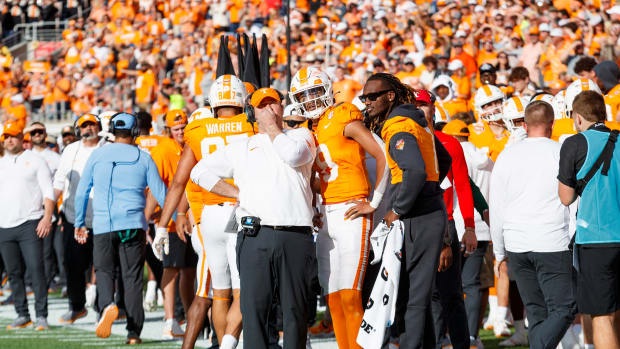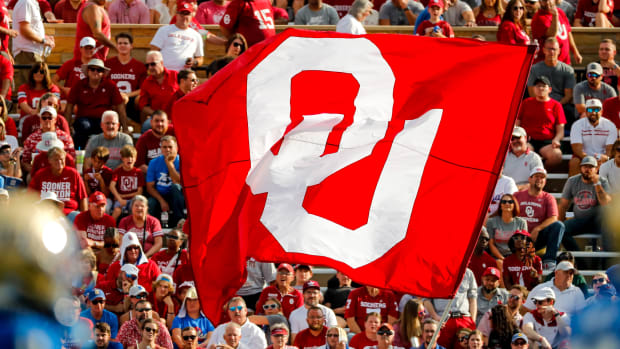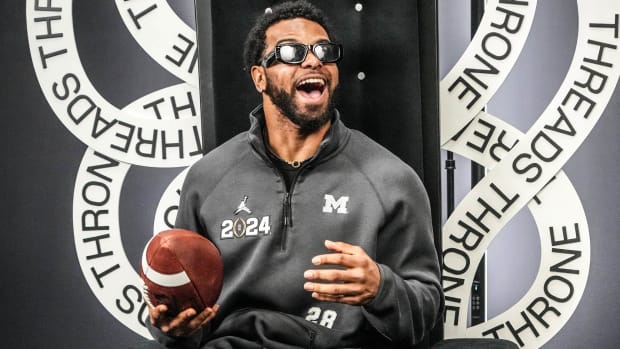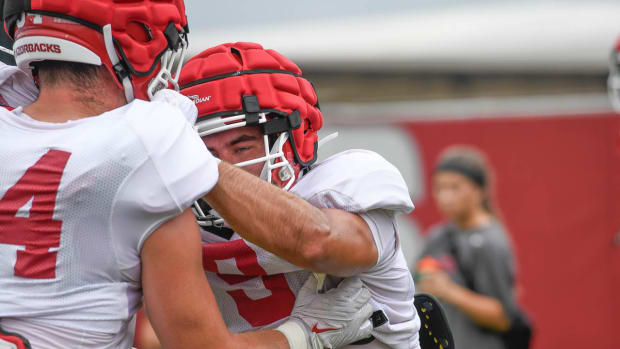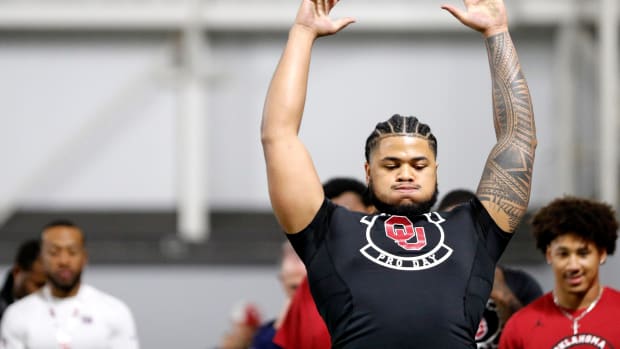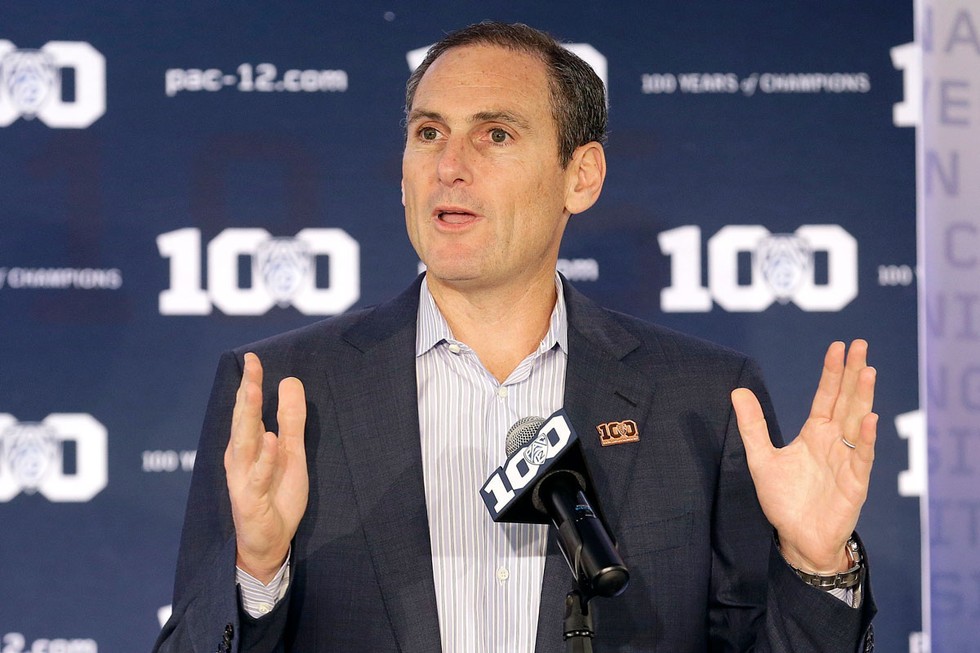
Larry Scott, Pac-12 schools make amends; now can they solve their network problems and increase revenue?
PHOENIX — If the tone of the people leaving the Pac-12's meeting room Thursday was a song, it would have sounded like this.
It felt genuine. It didn't seem as if anyone was putting on a face to hide lingering bad blood between various conference constituents and commissioner Larry Scott. There was bad blood, and there may still be some, but Scott was contrite about his past missteps, and the members of the league appreciated that.
Most notably, Scott expressed regret for the way he threw UCLA athletic director Dan Guerrero under the bus for voting the wrong way on the football satellite camp issue in an NCAA Division I Council meeting last month. It wasn't that Guerrero didn't screw up. He did. But Scott, already under fire for some issues he could control and some he couldn't, didn't need to make another enemy. The situation could have been handled more gracefully, and Scott made clear he understood that. He did not use the words "I'm sorry" in an interview, nor would he reveal what he said to Guerrero privately, but the sentiment seemed obvious.
"One thing I really regret is that became an issue around Dan and his integrity and character," Scott said. "Because he's held in very high regard by me and by our conference. The fact that he's our council representative tells you all you need to know. … In hindsight, I could have made the point I was trying to make and gotten a result without allowing any question about Dan's integrity."
The public blaming of Guerrero, and the anger it invoked within the conference, may have led to a better understanding between Scott and the league's athletic directors. They left Thursday feeling like he was listening, and that's a big step. Scott serves at the pleasure of the presidents and chancellors—not the ADs—but with the presidential roster in flux, he needed to do some coalition building.
Unlike in the Big 12, where some parties have continued a full-on freakout since failing to make the College Football Playoff field in 2014, the Pac-12 members have taken a more measured approach after their league missed the playoff in '15. They know how much deeper the conference is than it was five years ago. They also know two years of data aren't enough to identify trends.
Where they do match the Big 12 is in their concern about a growing revenue gap between the Big Ten, the SEC and everyone else. The Pac-12 Networks have not generated the kind of revenue for which members had hoped, and the television contract they cheered in 2011 now produces complaints about the number of night games. SEC fan bases get mad when their teams don't play enough prime-time games; in the Pac-12, fans whine when their teams play in prime time locally. They believe kickoff times—ESPN, Fox and Pac-12 Network broadcast games that start after 7 p.m. Pacific (10 p.m. Eastern) — put the league at a disadvantage with regard to playoff selection and national awards.
STAPLES: What is the future of college sports media rights deals?
Those who complain about night games conveniently forget that a Pac-12 player (Oregon quarterback Marcus Mariota) won the Heisman Trophy and led his team to the national championship game in 2014. They also tend to blame Scott for the kickoff times. He accepted that blame Thursday with a caveat that became a theme as he addressed each major complaint about the league's current situation. Scott noted that Pac-12 members, which were famously inflexible with regard to game days and kickoff times under former commissioner Tom Hansen, wanted more money from their television contracts.
One way to make more money is to be more willing to play games when television networks want to air them. ESPN would like to service West Coast viewers by broadcasting live games in local prime time on Thursday, Friday and Saturday. ESPN was willing to pay a little more for that ability. Scott's mandate when he negotiated the league's first- and second-tier rights deals, he said, was to maximize revenue so schools could spend more on better coaches and facilities. That came with a trade-off. ESPN and Fox got more say in when the games would be played. That was the deal they made. Some small changes might happen. For example, the league might try to convince its network partners to avoid making teams play consecutive road games at night. For the most part, though, the deal is the deal.
Scott's attitude is this: I gave you what you asked for. Don't start complaining now.
Marcio Jose Sanchez/AP
That theme also resonated as Scott addressed complaints that the Pac-12 Network's regional structure leaves national-feed games on standard-definition channels on some cable carriers. Scott said his mandate from the school CEOs when the network was created was to make a showcase for all of the league's sports. So, the Pac-12 created a network that shows 850 live events a year. The Big Ten Network shows more than 1,000 events a year, but many are aired exclusively on the Internet. For example, the network streamed 575 events in the 2013–14 school year. The SEC Network also broadcasts more than 1,000 live events per year, but like the Big Ten Network many are Internet-only. The Pac-12 Network is contractually obligated to show 850 live events on its television platform, and there are simply not enough open windows to do that on one national feed. So, viewers get some games on a regional Pac-12 network and some on a (sometimes more expensive) national feed. In March, Pac-12 Network president Lydia Murphy-Stephans explained to the Los Angeles Times that she subscribes to Comcast in the Bay Area and receives the Pac-12 Bay Area regional feed in high definition. The national feed, however, is available only in standard definition.
The league produces every game in HD, but it is up to carriers to carry them as such. Of course, the league could have insisted on having every game offered in HD in its carriage contracts, but it probably would have had to shave some off the subscriber fee to guarantee that extra bandwidth. If the conference didn't have to televise so many events, it could use a single feed and the events most viewers want—football and men's basketball games—would always be carried in HD. But the Pac-12 presidents and chancellors asked for a showcase for all sports. That, Scott said, is what he gave them.
Scott can't use that reasoning when it comes to the failure to get the Pac-12 Network on DirecTV. The network has 73 distribution deals, but nothing the league has tried—including an aggressive campaign asking fans to drop DirecTV—has worked to convince the nation's largest satellite provider to carry the network at the price the Pac-12 seeks. Jon Wilner of the San Jose Mercury News reported that Scott tried to ram through a DirecTV deal but was rebuffed by league members in an 11–0 vote with one abstention.
The bigger issue with the Pac-12 Network is the money it generates. Washington State athletic director Bill Moos revealed in a March letter to boosters that the school received only $1.4 million from the network. That puts the Pac-12 far behind the Big Ten and SEC, which have cable networks that should bring in between $8 million and $10 million per school this academic year. In that letter to boosters, Moos wrote his school had projected $5 million or $6 million a year from the network.
Scott said Thursday that he never promised huge revenue from the network, which is owned entirely by the conference. He said he provided schools with best- and worst-case scenarios—and everything in between—when the network was created. "I tried to always be careful to say that all we could be sure of was the worst case," Scott said. He noted that the network has never lost a penny, but acknowledged it hasn't come near the best-case scenario. "I'm not involved in the budgeting and planning that happens on the campuses and the assumptions that people made. I've tried to be careful. It's possible there has been some misalignment between what we hoped would happen and what athletics departments put in their plans."
STAPLES: What did the 2016 NFL draft tell us about college football?
Scott and the ADs spent much of Thursday working together on a cooperative initiative to help schools improve ticket sales and fan experiences—which also boost ticket sales—as well as on-campus fundraising. This is the only way Pac-12 programs can narrow the gap between themselves and programs in the SEC and the Big Ten.
USA Today recently compiled the annual revenues of every public-school Division I athletic department, and the first Pac-12 school listed was Oregon at No. 21. This doesn't mean the Pac-12 schools can't compete in football. After passing a certain minimum resource threshold, success comes down to coaching and recruiting. The Pac-12 has plenty of schools above that threshold, so the lack of network revenue is not a valid excuse. Still, the ADs would love to have more. So, they're open to ideas that could help them raise money on their campuses.
As Pac-12 ADs and officials met Thursday, the ballroom next door held one of those corporate events in which the CEO and CFO of a company compose their own rap song to pump up the sales force. At one point, the Pet Shop Boys' "Opportunities (Let's Make Lots Of Money)"blasted through the walls. Inside the Pac-12 room, the sentiment was probably we're trying.
The Pac-12 isn't going to catch the Big Ten or SEC, but the league can be plenty successful on the fields and courts at No. 3 in revenue. League members have to accept the consequences of some deals they made, and Scott needs to be willing to listen to the people doing the work on the campuses. If they can do all that, everything won't always be awesome, but it will certainly be better than it seemed two weeks ago.

